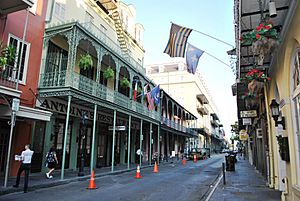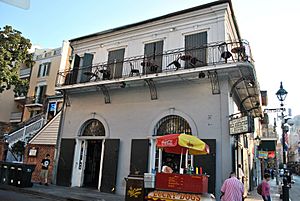French Quarter facts for kids
Quick facts for kids
French Quarter
Vieux Carré (French)
|
|||||||||||||||||||||||||
|---|---|---|---|---|---|---|---|---|---|---|---|---|---|---|---|---|---|---|---|---|---|---|---|---|---|
|
Neighborhood
|
|||||||||||||||||||||||||

The French Quarter, looking north with Mississippi River to the right
|
|||||||||||||||||||||||||
| Country | United States | ||||||||||||||||||||||||
| State | Louisiana | ||||||||||||||||||||||||
| City | New Orleans | ||||||||||||||||||||||||
| Planning District | District 1, French Quarter/CBD | ||||||||||||||||||||||||
| Area | |||||||||||||||||||||||||
| • Total | 0.66 sq mi (1.7 km2) | ||||||||||||||||||||||||
| • Land | 0.49 sq mi (1.3 km2) | ||||||||||||||||||||||||
| • Water | 0.17 sq mi (0.4 km2) | ||||||||||||||||||||||||
| Elevation | 3 ft (0.9 m) | ||||||||||||||||||||||||
| Population
(2010)
|
|||||||||||||||||||||||||
| • Total | 3,888 | ||||||||||||||||||||||||
| • Density | 5,890/sq mi (2,274/km2) | ||||||||||||||||||||||||
| Time zone | UTC-6 (CST) | ||||||||||||||||||||||||
| • Summer (DST) | UTC-5 (CDT) | ||||||||||||||||||||||||
| ZIP Codes |
70116 – 70130
|
||||||||||||||||||||||||
| Area code(s) | 504 | ||||||||||||||||||||||||
|
|||||||||||||||||||||||||
The French Quarter, also known as the Vieux Carré, is the oldest neighborhood in New Orleans. It means "Old Square" in French. The city was founded in 1718, and this area was its original center.
Today, the French Quarter is a very popular place for tourists and locals. Most of its historic buildings were built in the late 1700s or early 1800s. It is a National Historic Landmark, meaning it's a very important historical place. When Hurricane Katrina hit in 2005, the French Quarter was not flooded as badly as other parts of the city because it is on higher ground.
Contents
History of the French Quarter
How New Orleans Began
France claimed the land of Louisiana in the late 1600s. In 1718, Jean-Baptiste Le Moyne de Bienville founded New Orleans. Three years later, in 1721, an engineer named Adrien de Pauger designed the city's street plan. He named streets after French royal families and Catholic saints. For example, Bourbon Street was named after the French ruling family, the House of Bourbon.
Spanish Rule and Big Fires
In 1763, New Orleans was given to Spain after the Seven Years' War. Two big fires, one in 1788 and another in 1794, destroyed most of the city's buildings. Because of these fires, almost all the buildings you see in the French Quarter today were built after the late 1790s.
The Spanish leaders made new rules to prevent fires. They said buildings had to be made of brick covered in stucco, instead of wood. The old French roofs were replaced with flat, tiled ones. Even with these changes, people still built in a similar style, often adding wooden balconies and galleries like those seen in the Caribbean.
American Influence and Growth
After the United States bought Louisiana in 1803 (the Louisiana Purchase), many English-speaking Americans moved to New Orleans. They built their homes and businesses upriver, across what is now Canal Street. This wide street became a meeting point for the French-speaking locals and the new English-speaking Americans. The middle part of Canal Street was called the "neutral ground" because it was where both groups could meet and do business. This name is still used for medians in New Orleans today.
By 1840, New Orleans was a very important city. Its economy was based on selling crops like sugar, tobacco, and cotton. It became the third largest city in the U.S., and its port was the second busiest in the country, after New York City.
Famous Iron Galleries
The beautiful cast iron 'galleries' that New Orleans is known for started appearing around 1851. The Pontalba Buildings on Jackson Square were among the first to have these two-story iron balconies. They became very fashionable, and soon, many older wooden balconies were replaced with these new, fancy iron ones.
Changing Population
Over time, the French-speaking population became a smaller group in the French Quarter. In the late 1800s, many immigrants from Italy and Ireland moved into the area. The French Quarter was even nicknamed "Little Palermo" because so many Italian immigrants settled there.
In the early 1900s, the French Quarter became a less expensive place to live. This attracted many artists and writers. These new residents helped start efforts to protect the historic buildings. In 1925, the Vieux Carré Commission (VCC) was created to help preserve the district. This group gained more power in the 1940s to protect the French Quarter's unique look.

Protecting the Quarter
In the 1960s, there was a plan to build a big highway along the Mississippi River right next to the French Quarter. People who wanted to protect the historic area fought against this plan for many years. On December 21, 1965, the "Vieux Carre Historic District" was named a National Historic Landmark. Thanks to their efforts, the highway plan was stopped in 1969. This was a huge victory for preserving the French Quarter.
However, new challenges arose. Many new hotels were being built, sometimes replacing older buildings. In 1969, a rule was passed to stop new hotels from being built inside the French Quarter. But, other types of lodging, like timeshare apartments and hidden bed and breakfasts, still grew. In the 1980s, rents went up, and many long-time residents had to move out. The neighborhood became more focused on tourism, which is a big part of New Orleans' economy.
How Hurricane Katrina Affected the Quarter
The French Quarter is built on higher ground, about five feet (1.5 meters) above sea level. Because of this, it stayed mostly dry during Hurricane Katrina in 2005. Some streets had small floods, and a few buildings had wind damage, but most major landmarks were fine. The area also avoided much of the disorder that happened in other parts of the city after the storm.
The mayor reopened the French Quarter on September 26, 2005, about a month after the storm. Many businesses quickly reopened.
Recent Changes
In 2020, the Mayor of New Orleans, LaToya Cantrell, suggested stopping cars from being used in the French Quarter. This idea aims to make the area even more friendly for walking and exploring.
Geography of the French Quarter
The French Quarter is located at 29°57′31″N 90°03′54″W / 29.95861°N 90.06500°W. It sits about 3 feet (1 meter) above sea level. The district covers about 0.66 square miles (1.7 square kilometers). Most of this area is land, but about a quarter of it is water.
What are the Boundaries?
The French Quarter usually includes all the land along the Mississippi River from Canal Street to Esplanade Avenue. This is about 13 blocks long. It also stretches inland to North Rampart Street, which is about seven to nine blocks. In total, this makes up 78 city blocks.
Any changes to buildings in these blocks must be approved by the Vieux Carré Commission. This group makes sure that any new plans fit the historic look of the area. The official boundaries are Esplanade Avenue to the north, the Mississippi River to the east, Canal Street, Decatur Street, and Iberville Street to the south, and Basin Street, St. Louis Street, and North Rampart Street to the west.
Nearby Neighborhoods
The French Quarter is surrounded by other interesting neighborhoods:
- Faubourg Marigny (to the east)
- Central Business District (to the west)
- Iberville (to the north)
- Tremé (to the north)
Landmarks and Fun Places
Jackson Square: The Heart of the Quarter
Jackson Square is a public park in the French Quarter. It was originally called Place d'Armes (French) or Plaza de Armas (Spanish). In the mid-1800s, it was named after President Andrew Jackson, a hero of the Battle of New Orleans. In 1856, a statue of Jackson on a horse was placed in the center of the square. Before it was a park, it was used for military parades and even executions.
The square used to have a clear view of the Mississippi River. But in the 1800s, bigger levees were built, blocking the view. Later, a scenic walkway called the "Moon Walk" was built along the riverfront. In the 1980s, old warehouses were torn down to create Woldenberg Park, which extends the riverfront path all the way to Canal Street.
On the side of the square opposite the river, there are three important historic buildings from the 1700s. In the middle is St. Louis Cathedral, a beautiful church. To its left is the Cabildo, which was the old city hall. This is where the papers for the Louisiana Purchase were signed. To the right of the cathedral is the Presbytère, which looks just like the Cabildo. It was originally meant for priests but became a courthouse and is now a museum.
On both sides of the square are the Pontalba Buildings. These are long, red-brick buildings built between 1849 and 1851. The bottom floors have shops and restaurants, and the upper floors are apartments. These buildings were designed by Baroness Micaela Almonester Pontalba, who inherited a lot of land and money in New Orleans.
Across from Jackson Square is the Jax Brewery building. It used to be a local beer factory. Now, it has shops, restaurants, and even apartments. Behind it is the Toulouse Street Wharf, where the famous steamboat Natchez docks for tours.
From the 1920s to the 1980s, Jackson Square was a popular spot for painters, art students, and caricaturists. Today, you can also find tarot card readers, mimes, fortune tellers, and other street performers. Live music has been a part of the French Quarter for over a hundred years, and you'll often hear street musicians playing for tips.
Diagonally across from the Cabildo is Café du Monde. This famous open-air cafe is open 24 hours a day, except on Christmas. It's known for its café au lait (coffee with milk) and its delicious beignets, which are square pieces of fried dough covered in powdered sugar. They've been serving them since 1862! It's a tradition for first-time visitors to blow the powdered sugar off a beignet and make a wish.
Bourbon Street: Music and Fun
Bourbon Street is one of the most famous streets in the French Quarter. It's known for its lively atmosphere, especially at night. You'll find many jazz clubs with live music, making it a great place to experience New Orleans' musical heritage. The Napoleon House bar and restaurant is on Bourbon Street. It's named after a plan to rescue Napoleon from exile and bring him to New Orleans.
Delicious Restaurants
The French Quarter has many amazing restaurants, from fancy places to casual eateries. Some are very old and famous, like Antoine's and Tujague's, which have been open since the 1800s. Other well-known spots include Arnaud's, Galatoire's, Broussard's, and Brennan's.
You can also find restaurants by famous chefs like Paul Prudhomme ("K-Paul's") and Emeril Lagasse ("NOLA"). For a quick and tasty lunch, try Central Grocery on Decatur Street. It's the home of the original muffaletta, a famous Italian sandwich.
Education
The Orleans Parish School Board (OPSB) runs the public schools in the area. The Roman Catholic Archdiocese of New Orleans also operates Catholic schools. Cathedral Academy, which used to be St. Louis Cathedral School, was in the French Quarter. It opened in 1914 but closed in 2012.
Images for kids
See also
 In Spanish: Barrio Francés de Nueva Orleans para niños
In Spanish: Barrio Francés de Nueva Orleans para niños
- Buildings and architecture of New Orleans
- French Market
- French Quarter Festival, early April
- Jackson Square
- Louisiana Creole cuisine
- Satchmo SummerFest, early August
- List of National Historic Landmarks in Louisiana
- National Register of Historic Places listings in Orleans Parish, Louisiana















